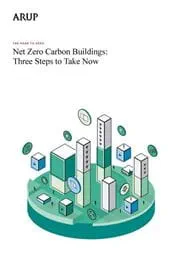Net zero commitments are taking hold all over the world with organisations at the heart of the global property sector making ambitious promises to decarbonise their portfolios and achieve net zero. Achieving net zero across all existing and new property assets will be a huge challenge, but one that must be embraced. What are the steps the industry needs to take now?
First, we need to define what we mean by ‘net zero carbon building’. Such a building does not necessarily have to achieve net zero energy consumption or net zero material impacts on site. For many buildings in an urban environment such objectives would be impossible to achieve. But a net zero building does need to have reduced its carbon impact to a level compatible with making a meaningful contribution to decarbonisation targets set at a sectoral, regional or national level.
Our definition must include buildings’ whole lifecycle carbon impacts. That’s the total carbon emissions associated with a building’s design, construction, maintenance, repair, refurbishment and demolition as well as its energy consumption during operation. Only this complete definition will give the property sector and its leaders confidence that the net zero goals they are pursuing will genuinely contribute to decarbonisation – and protect their assets from becoming stranded.
The importance of incorporating embodied carbon alongside operational carbon is easily illustrated if we think about a typical building in the UK. In this case, operational emissions from electricity and gas consumption typically make up a third to a half of many buildings’ whole lifecycle carbon impacts. We need to tackle these operational-phase emissions through good design and operations – in other words we need to minimise energy demand. We also need to offset residual operational emissions through renewable energy tariffs. But we shouldn’t kid ourselves that resolving operational emissions alone is enough to make our buildings truly net zero. Embodied carbon must be an integral element of net zero strategies for buildings – this is a central topic in our report Net Zero Carbon Buildings: Three Steps to Take Now.
Accreditation and commercial incentives
To turn warm words about net zero buildings into action, property owners and developers need to believe there is a workable commercial model. A clear market premium must emerge for buildings whose whole lifecycle carbon data demonstrates achievement of net zero or shows that a building has been designed and built to achieve net zero when it is operational.
Here we hit a problem. Even with growing interest in net zero buildings from some occupant groups within the UK and European property market, there isn’t yet a trusted way to differentiate a net zero building of any type from the rest of the pack. So why would developers invest in net zero carbon projects and accept additional upfront costs?
Getting to net zero is a complex journey, whether it’s an existing building undergoing refurbishment or a new-build. We can’t wait until the end of a building lifecycle before we reward buildings that have set themselves up to win. Rather like teams that compete in the Tour de France, we need to break the journey into stages and reward contributors along the way.
Setting new standards
One solution would be to find ways to accredit net zero elements of the design. In our new report, we have called this ‘net zero enabled’. This recognises a building’s design and construction data that proves it is able to achieve net zero carbon on a whole lifecycle carbon basis if, and when, it is operated effectively.
Buildings would achieve ‘net zero enabled’ based on criteria set by established market ratings. In the UK, the Better Buildings Partnership’s UK NABERS scheme is a big step forward, providing a robust mechanism for assessing the operational energy performance of buildings. That leaves creation of an embodied carbon rating scheme still to be tackled.
There is a lot of work to be done to clarify what percentage reduction in materials-related carbon emissions is needed to put a building on a course for net zero. How do we assess embodied carbon impact fairly and define targets consistently across different building types, markets and physical environments?
These are difficult questions that urgently require technically credible and market friendly answers. An incentive that allows buildings’ embodied carbon to be compared and rated is needed. Without one how can we expect asset owners and developers to invest consistently to minimise embodied carbon?
Operational carbon - the everyday commitment
Delivering net zero carbon buildings is not just about design choices. Achieving net zero fully is as much about how a building is operated and occupied as how it is designed and built. How we operate our buildings is the last piece in the net zero jigsaw.
Efficient operation flows from effective design, and as designers we may need to relearn the skills of design-for-operation that have eroded in the face of the compliance culture of recent years. The Australian property market has shown that transformation of the facilities management sector is possible when there is a clear incentive in place – the success of NABERS in the Australian market has led to a shift towards performance-based maintenance. A similar shift in the UK is well overdue.
The property sector has a huge role to play in achieving net zero and there is encouraging evidence that the market is ready for this transition. It’s up to us to provide the tools and incentive structures to make it happen.
 ;
;

